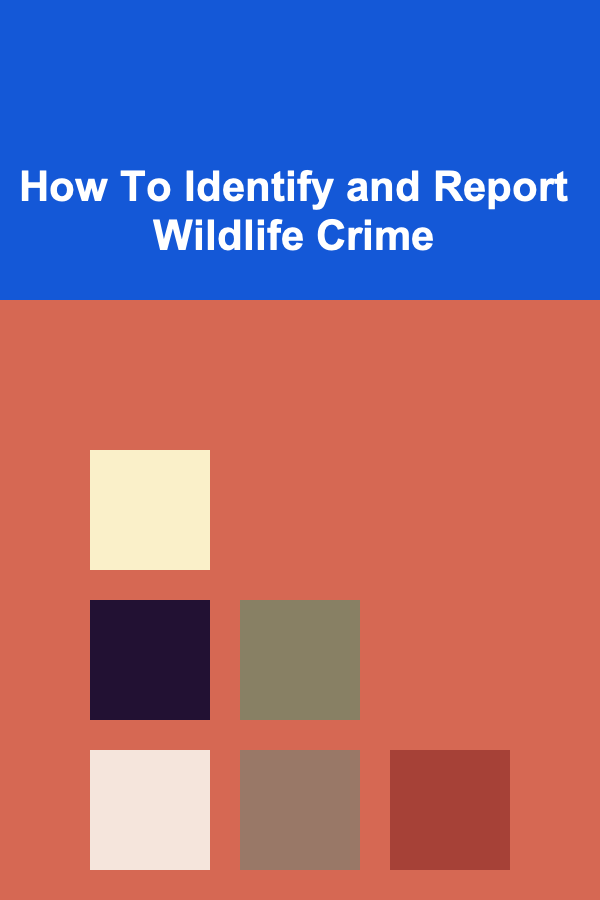
How To Identify and Report Wildlife Crime
ebook include PDF & Audio bundle (Micro Guide)
$12.99$9.99
Limited Time Offer! Order within the next:

Wildlife crime has become a significant global issue, threatening the delicate balance of ecosystems and leading to the decline of endangered species. From poaching to illegal trade, this form of environmental crime affects biodiversity and disrupts ecosystems that are vital for the planet's health. As awareness of this issue grows, individuals and communities can play a crucial role in identifying and reporting wildlife crime to protect wildlife and their habitats. In this article, we will explore the various types of wildlife crime, how to identify them, and how to report them effectively.
Understanding Wildlife Crime
Wildlife crime refers to any illegal activity involving the exploitation, harm, or trade of wild animals and plants. This can include a range of activities such as:
- Poaching: The illegal hunting, capturing, or killing of wildlife, often for profit or to fulfill demand for body parts like ivory, skins, or bones.
- Illegal Wildlife Trade: The illicit trade of wild species, their body parts, or products made from them. This includes the trade of exotic pets, medicinal products, and decorative items.
- Habitat Destruction: The unlawful destruction or disturbance of natural habitats, often due to deforestation, land conversion for agriculture, or industrial activities.
- Illegal Fishing and Hunting: Poaching or using illegal methods to capture marine life or terrestrial animals, often in protected areas or during prohibited seasons.
- Environmental Pollution: Activities like dumping harmful chemicals or waste into ecosystems, which can lead to the poisoning or destruction of wildlife.
These activities threaten the survival of many species and contribute to the broader environmental crisis, as ecosystems lose their biodiversity and stability.
Common Types of Wildlife Crime
- Poaching: Often carried out for profit, poaching involves the illegal hunting or capturing of animals. The primary targets are usually those with high demand in the illegal market, such as elephants for ivory, rhinos for horns, and big cats for their pelts.
- Illegal Wildlife Trade: This is one of the largest black markets in the world. Species like pangolins, tigers, and turtles are trafficked for use in traditional medicine, as exotic pets, or for ornamental purposes. The rise of e-commerce platforms has made it easier for wildlife crime to flourish.
- Deforestation and Habitat Loss: While not always immediately thought of as wildlife crime, illegal logging and the destruction of protected forests severely harm the species that depend on those ecosystems for survival. Deforestation driven by illegal activities can cause irreversible damage to biodiversity.
- Fishing Violations: Overfishing and the use of illegal, unregulated, and unreported (IUU) fishing methods are forms of wildlife crime. These practices deplete marine life populations, damage ecosystems, and pose a risk to species like sea turtles, whales, and sharks.
- Environmental Pollution: Dumping harmful chemicals, plastics, and waste into water sources or habitats can lead to contamination and the death of wildlife. Pesticides and other pollutants can poison the animals, disrupt food chains, and even affect human health.
The Importance of Identifying Wildlife Crime
Identifying wildlife crime is crucial for the effective protection of ecosystems and the prevention of biodiversity loss. Many of these crimes take place in remote or hidden locations, making them difficult to detect. However, the impact is widespread, affecting the health of entire ecosystems and threatening species with extinction.
The identification of wildlife crime also enables authorities to take the necessary legal actions, ensuring that perpetrators are held accountable. In many countries, there are specific laws and regulations in place that protect endangered species and regulate activities that harm the environment. Detecting and reporting wildlife crime is an important step toward ensuring these laws are enforced.
How to Identify Wildlife Crime
Being able to identify wildlife crime is a crucial step in protecting wildlife. Whether you're a conservationist, a concerned citizen, or a government official, knowing the signs of illegal activity can help prevent further damage. Here are some ways to identify different forms of wildlife crime:
1. Suspicious Hunting or Poaching Activities
If you encounter individuals who are hunting in areas that are protected, hunting during closed seasons, or using illegal methods (like traps or poison), these are clear indicators of wildlife crime. Here are some things to look for:
- Illegal Traps or Poisons: Traps that are illegal under national or international laws, such as snares, poisons, or other inhumane devices, often indicate poaching activities.
- Unusual Animal Kills: Finding carcasses of animals that have been killed under suspicious circumstances, especially in protected areas, could indicate poaching.
- Illicit Hunting: If individuals are hunting endangered species or in restricted zones (such as national parks), it's a red flag for illegal wildlife activity.
2. Illegal Wildlife Trade
The illegal wildlife trade can take place both locally and internationally. If you notice suspicious behavior related to the buying, selling, or transporting of animals or animal products, it could be a sign of illegal trade. Common indicators include:
- Unusual Pet Sales: If someone is selling exotic animals that are not native to the area or are not legally allowed to be traded, it is likely a form of illegal wildlife trade.
- Exotic Animal Products: Products made from wild animals, such as jewelry made from ivory or rhino horn, could indicate the illegal trade of endangered species.
- Trafficking Networks: Large quantities of animal parts or products being moved between locations, particularly across borders, may be part of a trafficking operation.
3. Damaged or Destroyed Habitats
Deforestation, mining, and industrial activities that damage natural habitats are illegal in many places, especially when done in protected areas. To identify this type of wildlife crime, look for:
- Unlawful Logging or Clearing: If you see illegal deforestation or logging activities in protected forests, national parks, or conservation areas, it could be a violation of environmental laws.
- Unauthorized Development: Building projects that disrupt ecosystems, particularly near conservation areas or along wildlife corridors, can be part of wildlife crime.
4. Fishing Violations
Fishing violations can involve overfishing, using banned fishing methods (such as dynamite or electric shock), or fishing in protected waters. Look for:
- Illegal Fishing Gear: The use of nets, hooks, or traps that are illegal in certain areas could indicate fishing violations.
- Fishing in Protected Areas: Fishing in national parks, marine reserves, or other protected waters is illegal and can contribute to wildlife crime.
- Bycatch: If non-target species are being caught in large numbers, it could be an indicator of illegal or unethical fishing practices.
5. Pollution and Contamination
Pollution, including chemical dumping, plastic waste, and other environmental contaminants, can harm wildlife. If you observe:
- Chemical Spills or Leaks: The illegal dumping of harmful chemicals or waste into natural habitats can lead to significant damage to wildlife.
- Plastic and Waste in Habitats: Excessive plastic waste, including discarded fishing nets and packaging, can entangle animals and poison ecosystems.
- Water or Soil Contamination: If you notice pollution affecting bodies of water or soil in wildlife-rich areas, it's important to report it as it may be a form of wildlife crime.
How to Report Wildlife Crime
Reporting wildlife crime is essential to curbing illegal activities and protecting biodiversity. By alerting the appropriate authorities, you help ensure that proper investigations are conducted and that violators are held accountable. Here's how to report wildlife crime effectively:
1. Know Who to Contact
In most countries, wildlife crime can be reported to local law enforcement agencies, environmental protection organizations, or specialized wildlife enforcement bodies. Some common authorities to contact include:
- Local Law Enforcement: Police or forest rangers are typically the first point of contact for reporting illegal hunting, poaching, or habitat destruction.
- Wildlife Conservation Organizations: Organizations like the World Wildlife Fund (WWF), Wildlife Conservation Society (WCS), or the International Union for Conservation of Nature (IUCN) often have hotlines or reporting systems for wildlife crime.
- National Environmental Agencies: Many countries have government bodies dedicated to the protection of wildlife and the environment, such as the U.S. Fish and Wildlife Service (FWS) or the Environment Agency in the UK.
- Border Control Agencies: If you suspect illegal wildlife trade, particularly cross-border trafficking, you can report it to customs and border control authorities.
2. Provide Detailed Information
When reporting wildlife crime, providing as much detail as possible is important to help authorities act swiftly and effectively. Here's what to include in your report:
- Location: Be specific about the location where the crime is occurring, including GPS coordinates if possible.
- Description of the Incident: Describe what you witnessed, including the type of crime (poaching, illegal trade, habitat destruction, etc.), any wildlife involved, and the number of perpetrators.
- Evidence: If you have photographic or video evidence, make sure to share it with the authorities. Documenting the crime can be invaluable for investigation purposes.
- Witnesses: If there were others involved or if you have seen others engaging in the crime, include their details if it's safe to do so.
3. Use Online Reporting Systems
In many countries, there are online platforms and hotlines dedicated to reporting wildlife crime. Some of these include:
- Wildlife Crime Hotline: Some countries have toll-free numbers or online reporting tools specifically for wildlife crime.
- Social Media Platforms: Many conservation organizations have active social media accounts where people can report suspicious activities.
4. Protect Yourself and Others
When reporting wildlife crime, always prioritize your safety. Avoid confronting suspects directly or putting yourself in harm's way. Instead, report the activity anonymously if necessary and provide as much information as possible to help authorities act.
Conclusion
Wildlife crime is a serious and growing global issue, and the responsibility of identifying and reporting such crimes falls on all of us. By recognizing the signs of poaching, illegal trade, habitat destruction, and other forms of wildlife crime, individuals can contribute to the protection of wildlife and the preservation of our planet's biodiversity. Reporting wildlife crime to the proper authorities can help enforce laws, punish violators, and deter future illegal activities. Everyone has a role to play in combating wildlife crime, and with awareness, vigilance, and timely action, we can make a positive difference in safeguarding our planet's natural heritage.

How to Build a Custom Tool Belt for Garden Tasks
Read More
How To Build Bio-Inspired Robots
Read More
How to Keep Your Home Safe While Traveling
Read More
How to Use Online Platforms for Vintage Item Organization
Read More
How To Use the Two-Minute Rule for Quick Tasks
Read More
What Are the Best Ideas for Organizing Your Home Gym?
Read MoreOther Products

How to Build a Custom Tool Belt for Garden Tasks
Read More
How To Build Bio-Inspired Robots
Read More
How to Keep Your Home Safe While Traveling
Read More
How to Use Online Platforms for Vintage Item Organization
Read More
How To Use the Two-Minute Rule for Quick Tasks
Read More